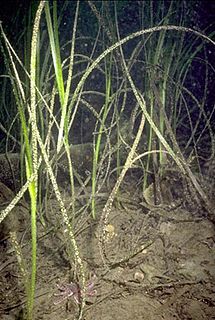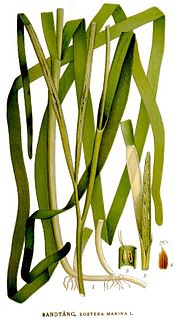
Zostera is a small genus of widely distributed seagrasses, commonly called marine eelgrass, or simply seagrass or eelgrass, and also known as seaweed by some fishermen and recreational boaters including yachtsmen. The genus Zostera contains 15 species

Zosteraceae is a family of marine perennial flowering plants found in temperate and subtropical coastal waters, with the highest diversity located around Korea and Japan. Most seagrasses complete their entire life cycle under water, having filamentous pollen especially adapted to dispersion in an aquatic environment and ribbon-like leaves that lack stomata. Seagrasses are herbaceous and have prominent creeping rhizomes. A distinctive characteristic of the family is the presence of characteristic retinacules, which are present in all species except members of Zostera subgenus Zostera.
Lottia alveus, the eelgrass limpet or bowl limpet, was a species of sea snail or small limpet, a marine gastropod mollusk in the family Lottiidae, the Lottia limpets, a genus of true limpets. This species lived in the western Atlantic Ocean.

Helicia is a genus of 110 species of trees and shrubs, constituting part of the plant family Proteaceae. They grow naturally in rainforests throughout tropical South and Southeast Asia, including India, Sri Lanka, Indochina, Peninsular Malaysia to New Guinea and as far south as New South Wales.
The Seagrasses of Western Australia are submerged flowering plants found along the coast, around islands, and in Estuaries of Western Australia. The region contains some of the largest seagrass meadows in the world, and is the most diverse in the number of species. The variety of habitats along its western and southern coasts is often soft sands in shallow subtropical waters, ideal for these plants.

Zostera marina is a flowering vascular plant species as one of many kinds of seagrass, with this species known primarily by the English name of eelgrass with seawrack much less used, and refers to the plant after breaking loose from the submerged wetland soil, and drifting free with ocean current and waves to a coast seashore. It is a saline soft-sediment submerged plant native to marine environments on the coastlines of northern latitudes from subtropical to subpolar regions of North America and Eurasia.

Cymodocea nodosa is a species of seagrass in the family Cymodoceaceae and is sometimes known as little Neptune grass. As a seagrass, it is restricted to growing underwater and is found in shallow parts of the Mediterranean Sea and certain adjoining areas of the Atlantic Ocean.
Grevillea molyneuxii, commonly known as the Wingello grevillea, is a shrub which is endemic to the shrublands of New South Wales in Australia.

Zostera noltii is a species of seagrass known by the common name dwarf eelgrass. It is found in shallow coastal waters in north western Europe, the Mediterranean Sea, Black Sea, Caspian Sea and Aral Sea and on islands in the Atlantic off the coast of northwest Africa. It is an important part of the intertidal and shallow subtidal ecosystems of estuaries, bays and lagoons.

Coleman's pygmy seahorse is a species of fish of the family Syngnathidae. It is found off of the coast of Lord Howe Island, Australia, although unconfirmed occurrences have been reported from Milne Bay and the Ryukyu Islands. It lives in coarse sand and Zostera and Halophila sea grasses at depths around 5 metres (16 ft). It is expected to feed on small crustaceans, similar to other seahorses. Ovoviviparous reproduction is also expected, with males brooding eggs in a pouch before giving birth to live young.
Zostera novazelandica Setchell is a species of seagrass in the family Zosteraceae found on the shores of New Zealand. It is regarded as a distinct species by some authors but considered as a synonym of Zostera muelleri Irmisch ex Ascherson by others. The Maori names for Zostera novazelandica are karepō, nana, rehia, and rimurehia.
Zostera asiatica is a species of eelgrass native to the shores of northeastern Asia: Japan, Korea, northeastern China (Liaoning), and the Russian Far East.
Zostera japonica is a species of aquatic plant in the Zosteraceae family. It is referred to by the common names dwarf eelgrass or Japanese eelgrass, and is native to the seacoast of eastern Asia from Russia to Vietnam, and introduced to the western coast of North America. It is found in the intertidal zone and the shallow subtidal, and grows on sandy, muddy and silty substrates.
Zostera caespitosa is a species of eelgrass native to the shores of northeastern Asia: Japan, Korea, northeastern China (Liaoning), and the Russian Far East.
Zostera capricorni is a species of eelgrass in the Zosteraceae family. It is native to the seacoasts of New Guinea, Queensland, New South Wales, Victoria, South Australia, Norfolk Island and the North Island of New Zealand. It was first discovered at Moreton Bay in Queensland in 1875.
Zostera muelleri is a southern hemisphere temperate species of seagrass native to the seacoasts of South Australia, Victoria and Tasmania. and New Zealand. Today, Zostera muelleri can be found in regions of Australia, New Zealand, and Papua New Guinea, as well as areas of the eastern Indian Ocean, and the southwest and western central Pacific Ocean. Zostera muelleri is a marine angiosperm, and is commonly referred to as eelgrass or garweed. It is a fast growing and readily colonizing species that serves as a feeding ground for wading birds and aquatic animals, and a breeding ground for juvenile fish and shrimp species.
Zostera tasmanica is a species of marine eelgrass in the Zosteraceae family. It is native to the seacoasts of Tasmania, New South Wales, Victoria, South Australia, and Western Australia.
Zostera chilensis is a species of eelgrass native to the seacoasts of the Coquimbo region of Chile.
Zostera caulescens is a species of eelgrass native to the shores of northeastern Asia: Japan, Korea, northeastern China (Liaoning), and the Russian Far East.
Zostera polychlamys is a species of eelgrass native to the shores of South Australia and Western Australia. It was first discovered at Flinders Bay in Western Australia in 1990.







